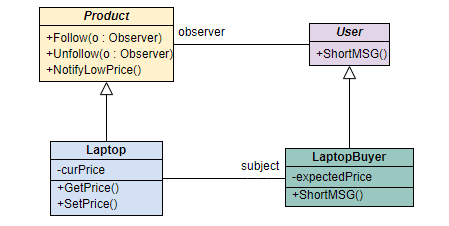观察者模式主要用于处理对象间的一对多的关系,是一种对象行为模式。该模式的实际应用场景比较容易确认,当一个对象状态发生变化时,所有该对象的关注者均能收到状态变化通知,以进行相应的处理。
本文希望通过简单的介绍和分析,能让读者对观察者模式有一个简单直观的认识和感知,以便在实际开发中根据需要灵活运用。
1. 目的
建立对象间一对多的关联关系,并能使一个对象的变化被所有关联对象感知。
2. 动机
建立一套低耦合的消息触发机制。
3. 优缺点
优点:
- 被观察者和观察者之间是抽象耦合的;
- 耦合度较低,两者之间的关联仅仅在于消息的通知;
- 被观察者无需关心他的观察者;
- 支持广播通信;
缺点:
- 观察者只知道被观察对象发生了变化,但不知变化的过程和缘由;
- 观察者同时也可能是被观察者,消息传递的链路可能会过长,完成所有通知花费时间较多;
- 如果观察者和被观察者之间产生循环依赖,或者消息传递链路形成闭环,会导致无限循环;
4. 应用场景
- 需要在系统中建立一个单项广播的触发机制;
- 系统中某个对象的行为会影响若干其他对象;
- 对象之间的关联关系可以在运行时动态的建立与撤销;
- 对象之间的关联关系呈现出一种树状结构;
5. 原理
下面是GoF介绍的典型的类观察者模式的UML类图:

Subject:
抽象被观察者,仅提供注册和删除观察者对象的接口声明。
ConcreteSubject:
具体被观察者对象,该对象中收集了所有需要被通知的观察者,并可以动态的增删集合中的观察者。当其状态发生变化时会通知所有观察者对象。
Observer:
抽象观察者,为所有观察者定义获得通知的统一接口;
ConcreteObserver:
观察者对象,其关注对象为Subject,能接受Subject变化时发出的通知并更新自身状态。
6.实现
接下来先将上面的UML类图转换为具体的代码,然后在举一个具体的例子来看一下其应用。
抽象被观察者类:Subject
public interface Subject { public void setState(int state); public int getState(); public void attach(Observer obs); public void detach(Observer obs); public void notify(String msg); }
抽象观察者类:Observer
public interface Observer { public void update(String msg); }
具体被观察者类:ConcreteSubject
public class ConcreteSubject implements Subject { private List<Observer> observerList = new ArrayList<Observer>(); private int state; @Override public void setState(int state) { this.state = state; notify("new state: " + state); } @Override public int getState() { // TODO Auto-generated method stub return 0; } @Override public void attach(Observer obs) { // TODO Auto-generated method stub observerList.add(obs); } @Override public void detach(Observer obs) { // TODO Auto-generated method stub observerList.remove(obs); } @Override public void notify(String msg) { // TODO Auto-generated method stub for (Observer obs: observerList) { obs.update(msg); } } }
具体观察者类:ConcreteObserver
public class ConcreteObserver implements Observer { @Override public void update(String msg) { // TODO Auto-generated method stub System.out.println("ConcreteObserver receive notify msg: " + msg); } }
演示:
public class Demo { public static void main(String[] args) { ConcreteObserver obs = new ConcreteObserver(); ConcreteSubject sub = new ConcreteSubject(); sub.attach(obs); sub.setState(666); sub.notify("just test subject notify function!"); } }
结果:
ConcreteObserver receive notify msg: new state: 666 ConcreteObserver receive notify msg: just test subject notify function!
7.实例
我们以一个更加实际的例子——商品价格的变动来体会一下观察者模式的用途。
在网上购物的时候,商品一般都有一个价格变动通知,前提是我们关注了该商品。
这里我们稍微变通一下,只有当关注的商品价格下降,且低于用户期望购买价格的时候,才会给用户发送一条商品降价的短信通知。

下面分别定义每个类:
产品抽象类:Product
public interface Product { public void setPrice(int price); public int getPrice(); public void follow(User user); public void unfollow(User user); public void notifyLowPrice(); }
用户抽象类:User
public interface User { public boolean isExpectedPrice(int price); public void shortMSG(String msg); }
商品笔记本电脑:Laptop
public class Laptop implements Product { private List<User> followList = new ArrayList<User>(); private int curPrice; @Override public void setPrice(int price) { curPrice = price; System.out.println("set laptop price: " + price); notifyLowPrice(); } @Override public int getPrice() { return curPrice; } @Override public void follow(User user) { followList.add(user); } @Override public void unfollow(User user) { followList.remove(user); } @Override public void notifyLowPrice() { String msg = "" + curPrice; for (User user: followList) { if (user.isExpectedPrice(curPrice)) { user.shortMSG(msg); } } } }
关注笔记本电脑用户类:LaptopBuyer
public class LaptopBuyer implements User { private int expectedPrice; private String userName; public LaptopBuyer(String userName, int expectedPrice) { this.userName = userName; this.expectedPrice = expectedPrice; } @Override public boolean isExpectedPrice(int curPrice) { // TODO Auto-generated method stub return curPrice <= expectedPrice; } @Override public void shortMSG(String msg) { // TODO Auto-generated method stub System.out.println("Your follow product have a low price: " + msg + " TO:" + userName); } }
演示:
public class Demo { public static void main(String[] args) { LaptopBuyer Alice = new LaptopBuyer("Alice", 6000); LaptopBuyer Jack = new LaptopBuyer("Jack", 6500); Laptop laptop = new Laptop(); laptop.follow(Alice); laptop.follow(Jack); laptop.setPrice(7000); laptop.setPrice(6500); laptop.setPrice(6000); laptop.unfollow(Jack); laptop.setPrice(5999); laptop.setPrice(6099); } }
结果:
set laptop price: 7000 set laptop price: 6500 Your follow product have a low price: 6500 TO:Jack set laptop price: 6000 Your follow product have a low price: 6000 TO:Alice Your follow product have a low price: 6000 TO:Jack set laptop price: 5999 Your follow product have a low price: 5999 TO:Alice set laptop price: 6099
上面的这个例子是一个能够很好地解释观察者模式的一个实际用途。
8. 总结
相比较与观察者模式,我们或许有许多获取另外一个对象状态的方式,比如,常见的轮询方式,或者仅仅在需要的时候去查一下对方的状态等,不过观察者模式有其特殊的用途,而且更加灵活。
该模式原理比较简单直接,但是实际使用过程中需要考虑一些细节问题:
- 何时通知?
- 有谁触发通知?
- 观察者是关注状态变化的次数还是最终的状态?
- 如果消息通知被阻塞,应该怎么办?
- 是否可以改为异步消息通知?
上面这些都是实际使用时应该考虑的。考虑清楚这些细节才能更灵活的应用该模式解决实际问题。
参考:
GoF《Design Patterns: Elements of Reusable Object-Oriented Software》
https://www.runoob.com/design-pattern/observer-pattern.html